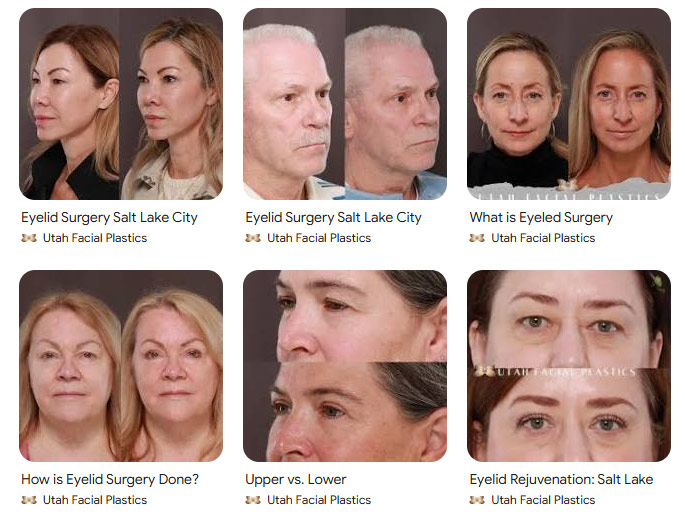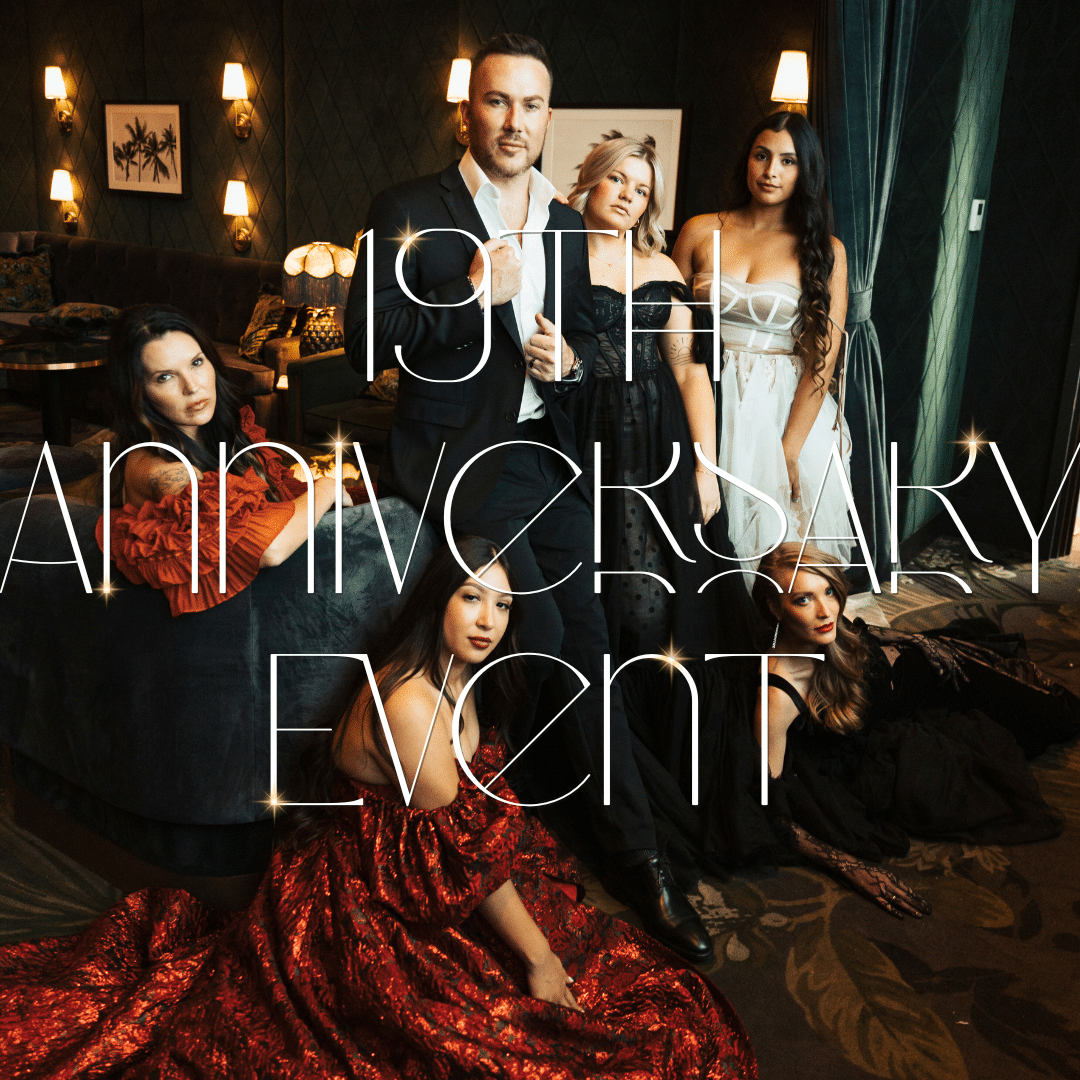Are you tired of looking in the mirror and seeing droopy eyelids that seem to age you beyond your years? You’re not alone. Many people feel like their eyes tell a story of fatigue and worry, even when they feel bright and vibrant inside. That’s where blepharoplasty, or eyelid surgery, comes into play! This popular procedure can enhance your appearance and give you that youthful glow you desire. In this article, we’ll explore the amazing transformations that blepharoplasty can offer, including both cosmetic and functional benefits. We’ll also take a closer look at the journey—from before the surgery to recovery—so you can understand what to expect every step of the way. Let’s dive in and discover how eyelid surgery could be the refreshing change you’ve been searching for!
Consider Utah Facial Plastics’ very experienced eyelid surgery surgeons, learn more here.
The “before and after” results of blepharoplasty typically show significant improvement in eyelid appearance, with reduction in excess skin, puffiness, and sagging, leading to a more youthful look. However, individual results can vary based on factors like surgical technique, skin type, and overall health.
Blepharoplasty Overview
Blepharoplasty, often referred to as eyelid surgery, is more than just a cosmetic intervention. This procedure holds great significance for individuals not only seeking to enhance their appearance but also those facing functional challenges due to sagging eyelids. Imagine waking up every day and feeling that your eyes are weighed down, obscured by excess skin. This can be bothersome—not just aesthetically, but it may even hinder clear vision.
The glory of blepharoplasty lies in its ability to address these concerns by removing surplus skin and sometimes fat from the eyelids. The process varies depending on each individual’s requirements; a surgeon may work on the upper eyelids, lower eyelids, or both, tailored to what you need most. The common complaints prompting many to pursue this surgery include wanting to achieve a younger look or experiencing difficulties with their vision.
Now, let’s break down the primary reasons individuals opt for this surgical procedure:
- Cosmetic Enhancement: Many seek blepharoplasty to reclaim a youthful glow around their eyes. By reducing puffiness and creating a more alert appearance, patients often feel rejuvenated.
- Vision Correction: It’s remarkable how droopy eyelids can obstruct peripheral vision. This surgical solution alleviates that pressure by tightening the area.
- Removal of Under-Eye Bags: Those pesky under-eye bags can age an individual well beyond their years. Correcting this issue gives a fresh look.
- Smoothing the Eye Region: Over time, fine lines and wrinkles accumulate around the eyes, leading to expressions that may not reflect one’s true feelings. Blepharoplasty smooths out these regions, allowing for more expressive features.
As you can see, blepharoplasty serves multiple purposes beyond aesthetics; it’s about restoring confidence as well as function. Understanding these motivations offers insights into why more people are pursuing eyelid surgery.
Upper and Lower Blepharoplasty by Dr. Henstrom
Individual results may vary.
Before and after of upper and lower eyelid surgery, 5 months after surgery.
View Angle: left-front-oblique
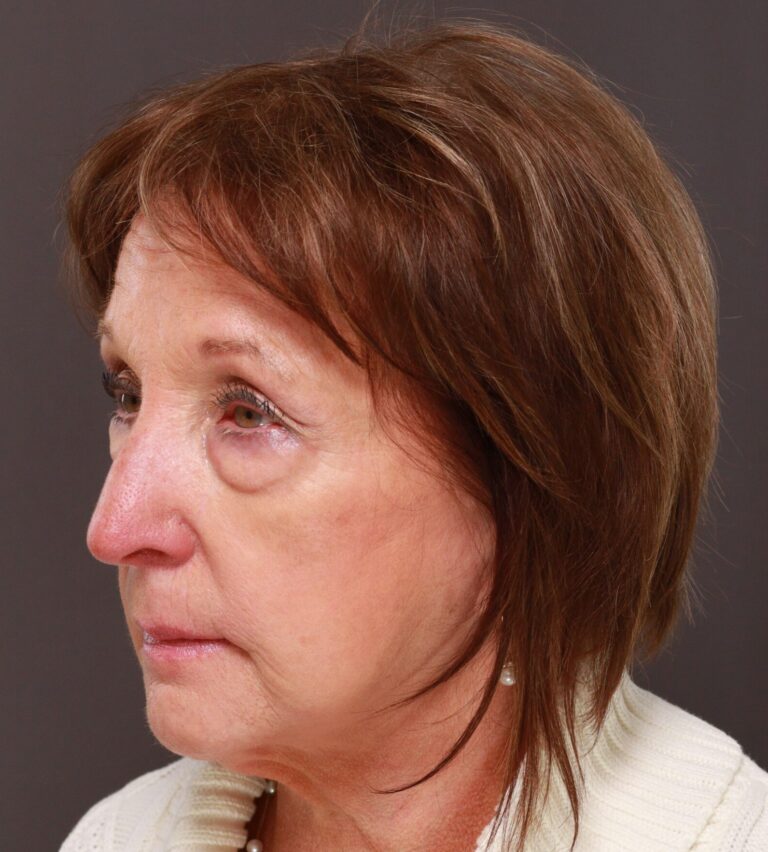 Before
Before
 After
After
View Angle: right-front-oblique
 Before
Before
 After
After
Before Photos and Assessments
Taking detailed before photos is not just a procedural formality—it’s a cornerstone in the blepharoplasty process. These images do much more than capture your current appearance; they serve as a baseline to assess post-operative results, allowing both the surgeon and the patient to visualize the intended changes.
The critical part of this stage is ensuring that multiple angles are captured, giving an overall view of the face and especially the eyes. The typical protocol involves taking 3-5 photos from various perspectives: frontal, lateral, and oblique views. By doing so, you enable corrections that hone in on specific features that may need adjusting or enhancing.
Moreover, before surgery can proceed, there’s an equally important aspect: understanding the patient’s medical history. This comprehensive assessment enables the surgeon to anticipate any potential complications during the procedure. A thorough evaluation might uncover previous conditions such as allergies, past surgeries, or even lifestyle factors like smoking and drinking habits that can impact healing and results.
This not only helps in strategizing surgical methods but also aids in setting realistic expectations regarding outcomes.
Surgical Procedures
Blepharoplasty, commonly referred to as eyelid surgery, can be a transformative experience, and its success largely depends on the techniques employed. Surgeons tailor their approach based on patients’ specific needs and desired outcomes. It’s fascinating how a single surgery can vary so much from one individual to another, reflecting the unique anatomical configurations of each person’s face.
Types of Blepharoplasty
Upper Blepharoplasty
The upper blepharoplasty is particularly noteworthy as it addresses droopy eyelids, a common concern among aging individuals. In this procedure, the surgeon makes an incision along the natural crease of the upper eyelid. This strategic placement not only ensures that any scars are less visible but allows for effective removal of excess skin, muscle, and sometimes fat. By doing so, this technique doesn’t just enhance aesthetics; it can also assist in improving vision obstructed by sagging skin.
Just picture someone who has been self-conscious about their eyelids now confidently opening their eyes wide, free from the weight of droopiness.
Lower Blepharoplasty
On the other hand, lower blepharoplasty focuses on the area beneath the eyes—an area that can betray age through puffiness or bags. The procedure involves making an incision just below the lash line or inside the lower eyelid. This dual approach allows surgeons to either remove excess fat or redistribute it effectively to create a smoother contour underneath the eyes.
Imagine waking up after this surgery and looking refreshed without those pesky shadows that had lingered for years.
With this understanding of surgical options, it’s essential to explore what comes next in the journey—considering how outcomes manifest visually and what patients can anticipate in terms of results post-procedure.
Post-Surgery Photos and Results
Upper & Lower Blepharoplasty with Fat Repositioning by Dr. Henstrom
Case ID: 48846
Individual results may vary.
Before and after of upper and lower eyelid surgery, 2 months post surgery
View Angle: front
 Before
Before
 After
After
View Angle:
 Before
Before
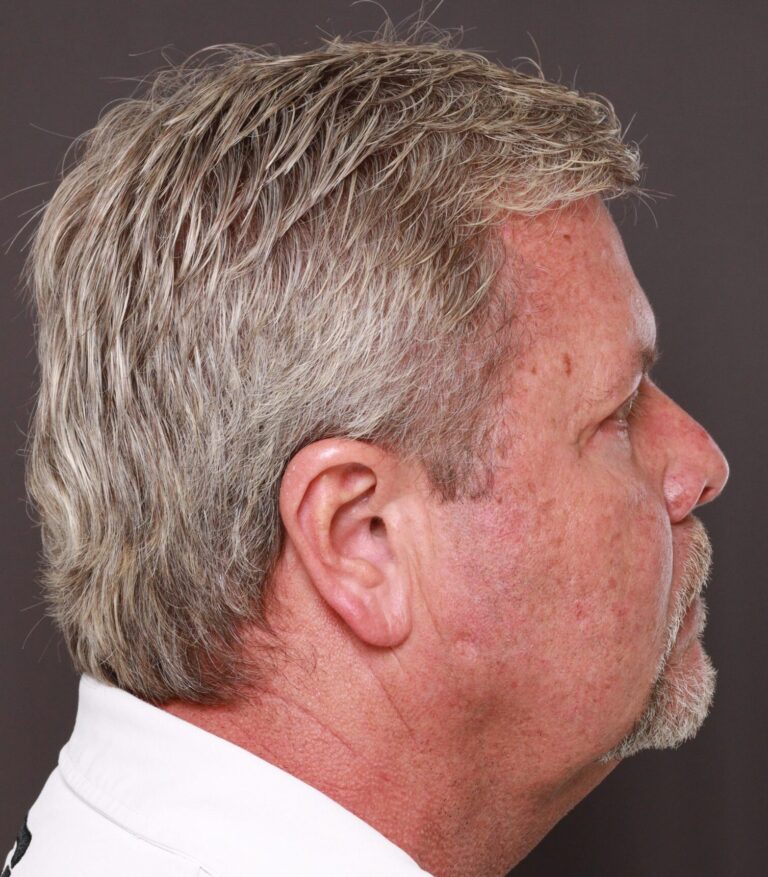 After
After
Facelift, Upper & Lower Blepharoplasty by Dr. Henstrom
Case ID: 18824
Individual results may vary. Facelift, Upper and Lower Eyelid surgery, 3 months post surgery
View Angle: front
 Before
Before
 After
After
View Angle: right-front-oblique
 Before
Before
 After
After
Facelift and Eyelid Lift by: Dr. Henstrom
Case ID: 20851
Individual results may vary. Facelift and upper eyelid lift, 7 months post operative.
View Angle:
 Before
Before
 After
After
See more before and after eyelid surgery pictures here.
Post-surgery photos are essential tools in understanding the impact of cosmetic procedures like blepharoplasty. These images, usually captured several weeks after the surgical intervention, offer a tangible way to assess the benefits and changes achieved through the procedure.
For many patients, seeing these side-by-side comparisons can be incredibly affirming, illuminating not just aesthetic differences but also changes in self-perception and confidence. It’s akin to flipping through an old family photo album; each image tells a story about growth and evolution.
One of the most notable observations from various before-and-after photo comparisons is the marked improvement in specific facial attributes. Patients typically report reduced puffiness around their eyes and smoother skin texture. Key differences include enhancements that are hard to ignore: eyelid drooping appears significantly less pronounced, the skin around the eyes looks rejuvenated and tighter, and pesky under-eye bags become much less visible.
Not only do these visual testimonials speak volumes about the surgery’s success, but they also reveal how results can vary depending on individual circumstances and surgical skill.
However, achieving these remarkable results isn’t merely a matter of undergoing surgery; it’s about embracing a holistic approach during recovery. Proper aftercare plays a pivotal role in ensuring satisfaction with one’s results.
Patients must adhere to guidelines provided by their surgeons diligently—this includes managing swelling with prescribed medications, applying cold compresses appropriately, and avoiding strenuous activities that might compromise healing.
Moreover, follow-up appointments serve as checkpoints where both physicians and patients evaluate progress together. Patience is key; while initial healing may start showing improvements within weeks, final outcomes often take three to six months for full visibility due to natural healing processes.
Post-surgery photos offer more than just a visual confirmation of changes. They serve as powerful reminders that beauty standards can be personalized journeys defined by individual self-discovery rather than societal expectations—and therein lies the true beauty of procedures like blepharoplasty.
Recovery Tips and Healing Process
A smooth recovery is vital for optimal results following blepharoplasty. The healing journey can be divided into distinct stages, each requiring careful attention to postoperative care instructions. During the initial recovery phase, which spans the first week, patients will notice swelling and bruising around their eyes. This can feel disheartening, but it’s important to remember that this is a normal part of the healing process.
To ease these symptoms, applying cold compresses for 10-20 minutes every hour during the first 48 hours can significantly reduce swelling. Keeping your head elevated while resting will also promote better blood flow and minimize puffiness.
In addition to managing swelling, getting ample rest is crucial during this stage. Your body needs energy to heal! It’s wise to stick to light activities and avoid strenuous exercise for at least two weeks post-surgery. If discomfort arises, taking over-the-counter pain relievers as recommended by your surgeon can help ease your pain and enable a more comfortable recovery.
As you transition into the intermediate recovery phase—typically occurring between weeks two and three—you’ll likely notice a significant decrease in swelling and bruising, although mild discomfort may persist. Following up with your surgeon during this time is essential; not only does it help ensure that your eyes are healing correctly, but it also provides an opportunity for any concerns to be addressed.
Protecting the delicate skin around your healing eyes is equally important. Wearing dark sunglasses when outdoors will shield against harsh sunlight, while applying a gentle sunscreen will further protect against photodamage.
By four to six weeks post-surgery, complete recovery should be well on its way. At this point, most patients find that scars have become minimal and are no longer noticeable. This allows for makeup application to cover any remaining signs of surgery if desired—just be cautious and follow your surgeon’s recommendations regarding products and techniques for makeup usage on sensitive skin.
Taking care of yourself throughout this process is key to ensuring that you emerge from surgery with the best possible outcome.
Understanding how you can support your healing journey opens the door for experiencing the aesthetic benefits of blepharoplasty fully. With thoughtful attention to recovery phases—from initial rest to applying protective measures—you’ll set yourself on a path toward achieving your desired results while nurturing your well-being along the way.
As you immerse yourself in the nuances of recovery, considering who will guide you through this journey becomes equally crucial for achieving your aesthetic goals.
Selecting the Right Surgeon
Picking a qualified and experienced surgeon is perhaps the most crucial decision in your blepharoplasty journey. You wouldn’t trust a car mechanic without a good reputation or one who hasn’t worked on vehicles similar to yours; it’s no different when it comes to surgical procedures. A well-trained surgeon is essential for ensuring both aesthetic success and safety during the operation.
Choosing wisely from the beginning can impact not just your physical results but also your emotional experience throughout the process.
As you begin this important search, consider looking for board-certified plastic surgeons or oculoplastic surgeons who specialize specifically in eyelid surgery. Their expertise will be tailored to the unique anatomical nuances of the eye area. Additionally, take time to review their portfolio of before-and-after photos; it’s an excellent way to gauge their skill level and artistic style. You want a surgeon whose previous work resonates with what you envision for yourself.
Key Considerations
When evaluating potential surgeons, several factors should weigh heavily in your decision-making process. To help you stay organized, here’s a quick reference table:
| Factor | Recommendations |
|---|---|
| Board Certification | Ensure the surgeon is board-certified in plastic surgery or oculoplastic surgery, indicating rigorous training and standards. |
| Experience | Opt for a surgeon who has performed multiple successful blepharoplasties. This guarantees familiarity with various techniques and complications. |
| Patient Reviews | Read testimonials and reviews from previous patients. Positive experiences and results often highlight reliable skill levels. |
| Consultation Process | Ensure the surgeon conducts a thorough initial consultation, discussing what to expect and addressing all your questions without rushing the conversation. |
| Facility Accreditation | The surgical facility should be accredited and meet health and safety codes, as this is vital for preventing complications during surgery. |
While credentials are important, it’s equally vital to feel comfortable communicating with your surgeon. They should listen to your concerns, provide honest feedback, and set realistic goals based on what is medically possible for your individual situation. After all, enhancing your appearance should come hand-in-hand with feeling confident in the decisions you make regarding your body.
Remember that even after selecting an exceptional surgeon, setting realistic expectations is key to satisfaction post-surgery. It’s not just about looking younger; it’s about feeling more oneself as well—understanding that natural-looking enhancements can subtly elevate one’s features without dramatically altering them.
Consider Utah Facial Plastics’ very experienced eyelid surgery surgeons, learn more here.
Setting Realistic Expectations
Preparing for blepharoplasty doesn’t just involve selecting a skilled surgeon; it also entails understanding what results to anticipate. One of the keys to a fulfilling experience lies in acknowledging both the capabilities and the limitations of the surgery. While many patients report satisfaction—about 70% after one year—it’s essential to remember that no cosmetic procedure can promise absolute perfection.
It’s crucial to recognize that while blepharoplasty can significantly refresh your eye area, improvements may not be as dramatic as some might hope. For instance, those looking for a complete transformation may find themselves disappointed. Even well-executed procedures can yield variations based on individual factors such as skin elasticity and anatomy.
Patients with realistic expectations tend to be much happier with their results. An enhanced but natural look should be the goal rather than striving for unachievable ideals.
Upper & Lower Blepharoplasty by Dr. Thompson
Case ID: 0794
Individual results may vary.
69 year-old male with facelift, fat injections, upper & lower blepharoplasty (eyelid lift), and pre-jowl implant from Dr. Scott Thompson in SLC, Utah.
View Angle: front
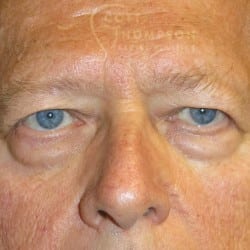 Before
Before
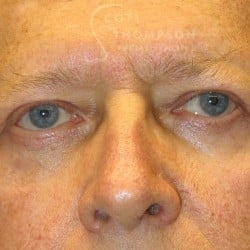 After
After
Facelift & Upper Blepharoplasty by Dr. Thompson
Case ID: 18926
Individual results may vary.
Facelift & Upper Eyelid Surgery, 3 months post surgery
View Angle:
 Before
Before
 After
After
The Role of Patient Education
Think of it this way: it’s like expecting a pumpkin seed to grow into a grand oak tree overnight. With proper nurturing and time, it can flourish beautifully—but it won’t happen in an instant! Similarly, post-surgery recovery requires patience and care.
Furthermore, many surgeons emphasize educating patients about what constitutes a reasonable expectation. Dr. Smith suggests that honest conversations about desired outcomes are pivotal.
He explains how patients who aim for subtle enhancements often find contentment with their appearance, while those seeking more exaggerated changes might experience dissatisfaction if reality doesn’t meet their preconceived notions.
Knowing about potential side effects is also vital. Minor complications such as dry eyes or temporary blurred vision affect around 20% of patients. These outcomes typically don’t signal disaster but underline the importance of understanding that every surgery comes with its risks.
This level of awareness not only cushions against disappointment but also fosters an appreciative mindset towards the changes your body will undergo—significant improvements without straying too far from your original look. Embracing beauty makes it easier to accept and celebrate transformation rather than dwelling on unrealistic benchmarks.
In seeing results, understanding and respecting realistic expectations ensure that you appreciate the journey and outcome of blepharoplasty fully.
More Resources
- The Benefits of Eyelid Surgery
- How is Eyelid Surgery Done?
- 5 Things To Know Before Considering Eyelid Surgery
- Mom, Why Are You Angry? What Eyelid Surgery Can Do For You
- Three Different Types of Eyelid Surgeries
- What to do when your eyelids are obstructing your vision
- Does a Blepharoplasty Hurt? How Painful is Eyelid Surgery?
- How Long Does Blepharoplasty Last: Effects and Recovery Explained
To view more before and after images or to learn more about eyelid surgery in the Salt Lake City, Draper, or Layton, UT areas, fill out our consultation form or contact us at 801-960-3137.
